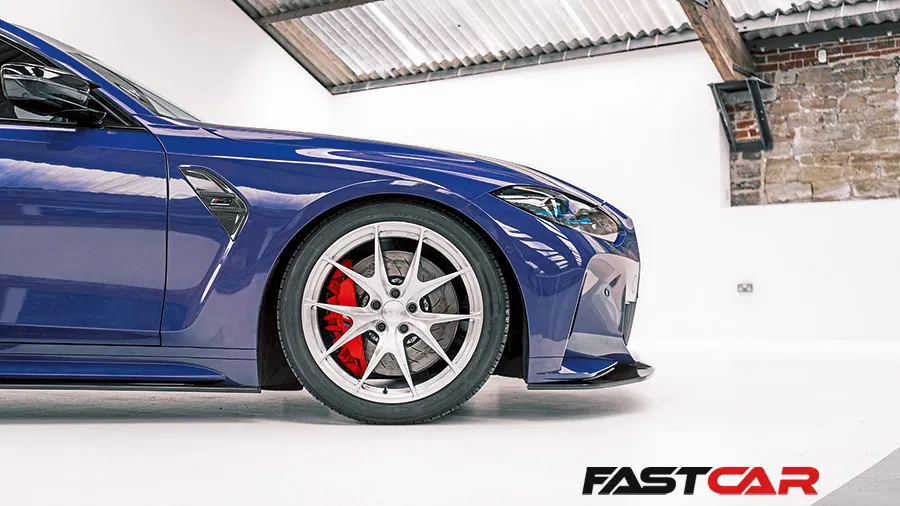Don’t forget about upgrading your brakes in the pursuit of more performance. Slowing down is just as important as speeding up. Here are some of the best brake pads and rotors on the performance aftermarket.
For the vast majority of people who enjoy modifying cars, the end goal is more performance. You want to go faster. But, it’s important to remember that the brakes fitted to the car from the manufacturer will almost certainly not be up to the job of dealing with more power. The faster you go, the more braking performance you need to ensure you can suitably stop.
There are a few options when it comes to upgrading your brakes. You can go for a larger caliper, rotors/discs and brake pads to drastically improve your braking. You can also simply fit a rotor and brake pad combination that are designed to withstand more pressure and heat. Or you can simply upgrade the brake pad. Either way, you’ll see an improvement in braking performance. For my latest project, given I’m not pursuing more power, I’ve opted for a simple rotor and pad upgrade, utilizing a grooved rotor, Ferodo DS2500 pads and Goodridge braided brake lines.
How I picked the best brake pads & rotors
Below, I’ve picked out some of the brands that I know to be great upgrades for any standard or modified car. All of the brands have ranges that are suited to just road driving and occasional track day use, right up to full on track day use and race cars. It’s important that you select a product that is right for you. Track pads on a road car can be frustrating!
In selecting the products below, I’ve used my personal experience (as well as that of other members of the Fast Car team, who have been modifying vehicles for the past two decades or so) to come up with a set of recommendations that I’d be happy to use on my own car.
Best Brake Pads & Rotors
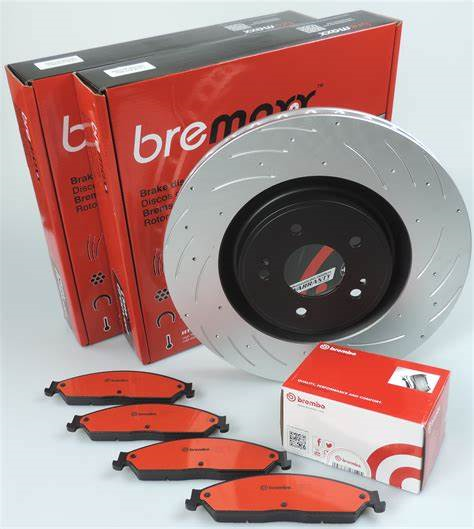
Brembo
Brembo is probably the most well-known brakes manufacturer on the planet, and for good reason. There isn’t a single other braking system manufacturer that can claim the sort of technical innovation and motorsport prestige that Brembo has achieved.
To give you an idea, Brembo brakes have played a part in 26 Formula One driver’s championship titles. They’ve also had 30 constructor’s championship wins. They’re trusted by numerous performance marques across the globe to provide the braking systems for their OEM models. So, if you’re after a quality performance upgrade, you’ll be in safe hands.
Brembo’s current entry-level rotor upgrade is the TY3 disc. However, despite its modest positioning within Brembo’s product hierarchy, the TY3 is still super capable. In fact, it’s the design that teams in the FIA World Touring Car Cup (WTCR) use on their race cars! The TY3’s slotted design helps to improve friction between the rotor and the pad. This in turn enhances braking performance.
Speaking of pads, the TY3 disc has been designed to work perfectly in conjunction with Brembo’s Sport HP2000 pads. These operate consistently across all temperatures up to 600 degrees Celsius (1112 F), as well as providing quiet functionality. For fast road builds, these two upgrades alone will make a notable difference when travelling at a more serious pace.
Want to get a set? Buy Brembo brake parts here.
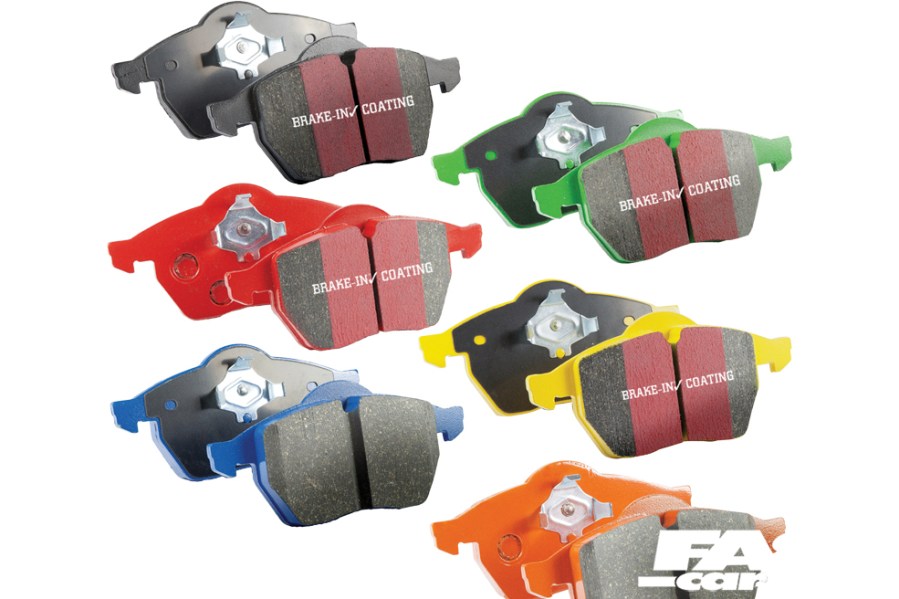
EBC Brakes
Despite the well-publicized difficulties posed by Brexit, British-based company EBC Brakes remains a key European market supplier of performance rotors and pads.
EBC’s most well-known products are its color-coordinated range of brake pads. The list of options begins with the ‘GreenStuff’ pads, intended for use on street-focused sports sedan or hot hatch builds, while RedStuff pads are for heavier and faster street cars & SUVs. Those red ones also provide the added benefit of minimal brake dust.
If you want to take things up a notch, YellowStuff pads provide the best balance between performance, refinement, and longevity. As a result, they’re currently EBC’s best-seller. Ideal for fast road driving, YellowStuff pads can also cope with infrequent track days. Though, if you plan on spending more time on the circuit, EBC’s got some more hardcore pads available too.
BlueStuff is for both road and track use, but there’s much more of an emphasis on circuit driving. Expect high friction, but potentially also higher wear and noise. Finally, OrangeStuff pads are for the circuit only. These offer the most performance, but you need to bed them in. They’re also technically not road-legal.
If you’ve got you’re head around all of that, let’s move on to rotors. EBC’s USR Series slotted discs are ideal for those of you who want to cruise around in peace and tranquility. These rotors provide a mostly silent braking experience, especially when you pair them with RedStuff pads. Wear and tear is also very low. Alternatively, EBC’s GD Sport rotors should appeal to the more performance-minded individuals amongst you. Unique wide slots help to cool both the rotors and the pads, while their dimpled design helps to disperse debris without affecting structural integrity (unlike drilled-through alternatives).
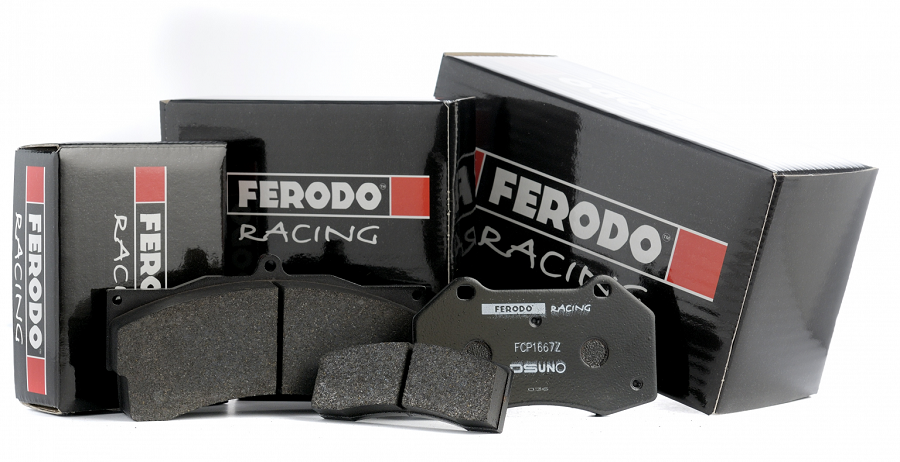
Ferodo
With more than 100 years of experience, Ferodo is undoubtedly one of the world’s best brakes suppliers. In fact, they claim to be the creator of the very first brake pad!
The British brand’s perforated rotor design prevents any build up of moisture or debris between the disc and pads, allowing for consistent, predictable performance. They also come lathered in Ferodo’s COAT+ anti-corrosion finish.
As for their range of pads, the FUSE+ package is likely to appeal to most readers. Having taken three years to develop, these attempt to offer the perfect balance between friction and passenger comfort. 75 different materials were tested in the process, before Ferodo finally settled on a combination of 20. As a result of this mixture, you’ll gain enhanced pedal feel over your standard pads, and less noise than some other high performance options. What’s more, the pads are constructed using Ferodo’s patented ‘Eco Friction’ tech, which emits less wheel dust and cuts emissions.
Keen track day drivers will be interested to know that Ferodo has a whole racing division set up to provide brake pads for circuit driving. These are a harsher compound and likely to result in more noise and brake dust, but if it’s pure performance for your track car that you’re after, then those are the way to go.
Want a set of Ferodo pads? Buy them here.
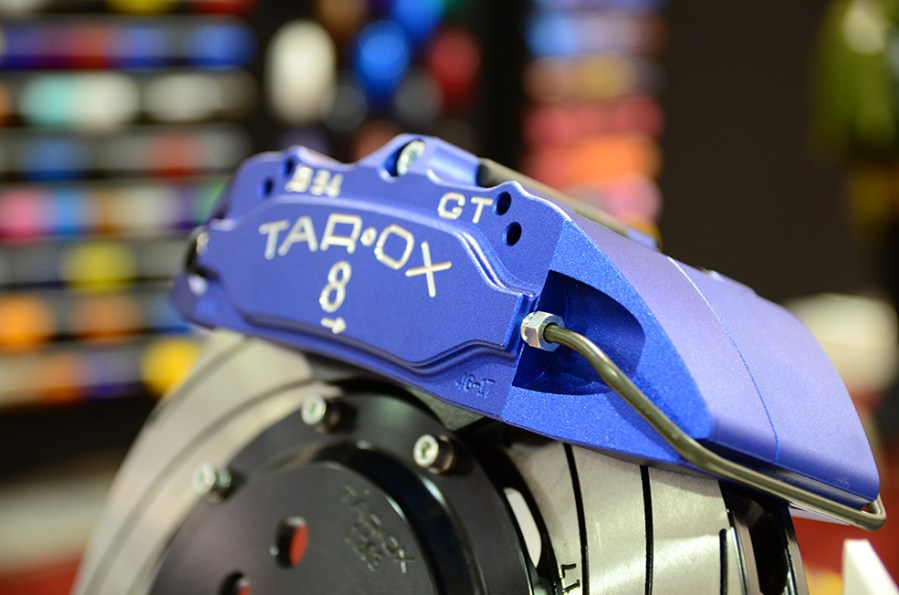
Tarox
Tarox offers four different types of aftermarket brake rotor, and a three-tiered range of pads. If you like brands that do things differently, you’ll love these…
Tarox Brake Rotors
The defining element of Tarox rotors has to be their overtly unique slotting designs. Let’s start with the F2000 rotors, which, to the eye, appear the most ‘normal’. Originally a track-only rotor, the F2000 disc has since been refined for street use in higher powered hot hatches and sports saloons. Its spiral grooves allow for a good blend between heat dissipation and structural integrity. This in turn provides a notable performance increase over standard OEM rotors. Then there’s the G88 disc, which might be the most visually interesting brake rotor we’ve ever seen. This thing is absolutely covered in cooling grooves from edge to edge, though the perimeter of the rotor is chamfered in order not to cause too much pad wear. If you’re put off by such a novel design, don’t be – Tarox G88s have been popular in the tuning scene since 1988.
Next up, the Tarox Sport Japan rotors feature a drilled design. This is a much more aggressive solution to cooling compared to slots/grooves, and as such, the drilled holes have been strategically placed in order to retain the rotor’s structural integrity. Finally, Tarox ZEROs don’t have any slotting or drilling at all. Instead, they get their performance gains from the materials used. This high-grade cast has been tested relentlessly in production car racing, and according to Tarox, will lasts twice as long at high temperatures compared to a regular OEM plain disc.
Tarox Brake Pads
Moving onto brake pads, the Tarox Strada is likely to be the most popular, designed primarily for fast road & street use. Tarox Corsas are still just about refined enough for street use, but really, it’s only worth buying these if your car’s going to spend most of its time on the track instead. Finally, the Tarox Enduro is for the hardcore, genuine competition cars. These have a much higher operating temperature, so we wouldn’t recommend putting them on your street build. However, if you’re building a car for time attack or grassroots motorsport, the Enduro pads will serve you well.
Fancy a set? Buy Tarox brake components here.
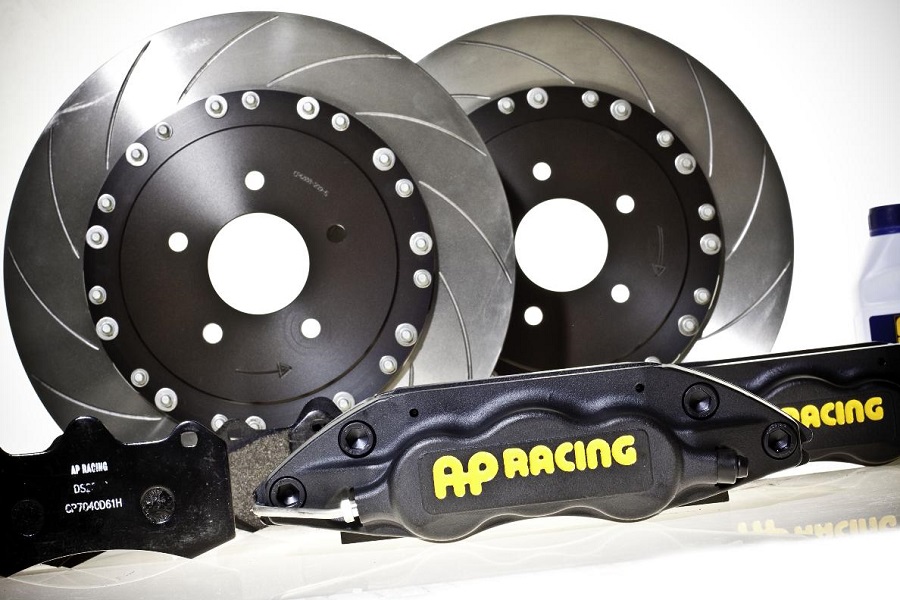
AP Racing
AP Racing has become one of the best brake companies in the world, thanks to its ‘Race to Road’ approach to development. In short, all of AP’s core technology has been engineered to succeed on the race circuit. This tech trickles down into OEMs and the street performance aftermarket.
Arguably, AP Racing’s biggest specialty is actually brake calipers, rather than rotors or pads. There’s several to choose from, including the World Radi-CAL 1, which is a two-piece design, or the World Radi-CAL 2 – which offers less mass, improved rigidity and better cooling characteristics. The best of the bunch, though, is the Mono R – a monobloc caliper which is even stronger than the two-piece Radi-CALs. Mono Rs will perform well on any vehicle up to 3500kg!
Need something a little more hardcore? Check out AP Racing’s track-focused product range instead.
Click here to buy brake parts from AP Racing.
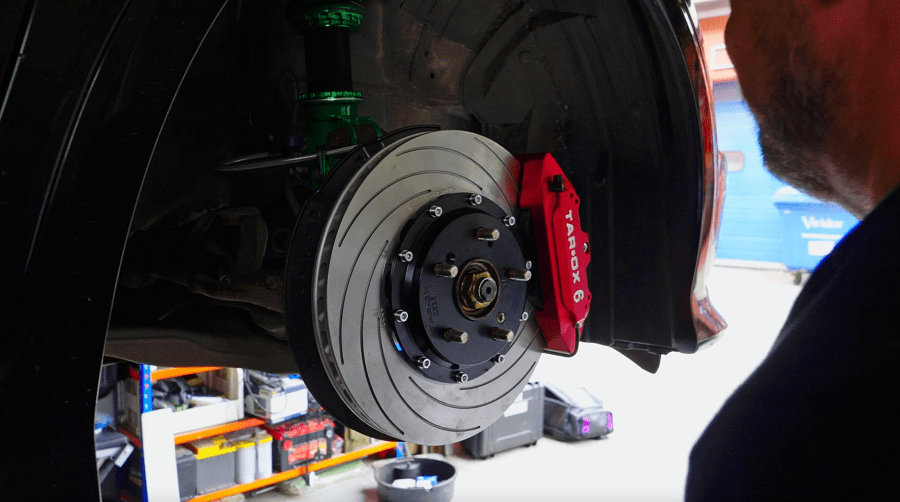
Once you’ve decided which rotor and pad package is right for you, you’ll need to know how to fit them next…
What types of brake pads are there?
Brake pads are made from strong hard materials that wear away over time. Pads strike a balance between being hard enough to cause lots of friction but not harder than the brake discs. The idea is the brake discs don’t deteriorate over time in the same way the pads do. The pads should wear away and be replaced more frequently than the discs. There’s different types of pads depending on the vehicle and the type of driving you do.
- Organic: These tend to be the cheapest option but have the shortest life span.
- Semi-metallic: As the name suggests, metal is included in the mix, this makes it more hard wearing and extends its life expectancy. These can cause the brake discs to wear more quickly than other types of brake pads.
- Ceramic: This is the most expensive option but for owners looking to frequent the track, these are likely to be the best choice. They last longer and provide superior performance above other types of brake pads which is essential on a track or the road with a high performance car.
What is a brake rotor?
In simple terms, the brake rotor is a large circular plate that’s connected to the wheel. When you want to slow your car down, the pistons inside the brake caliper push against the brake pad. This in turn rubs against the rotor. The resulting friction turns kinetic energy (movement) into thermal energy, thus reducing your car’s speed.
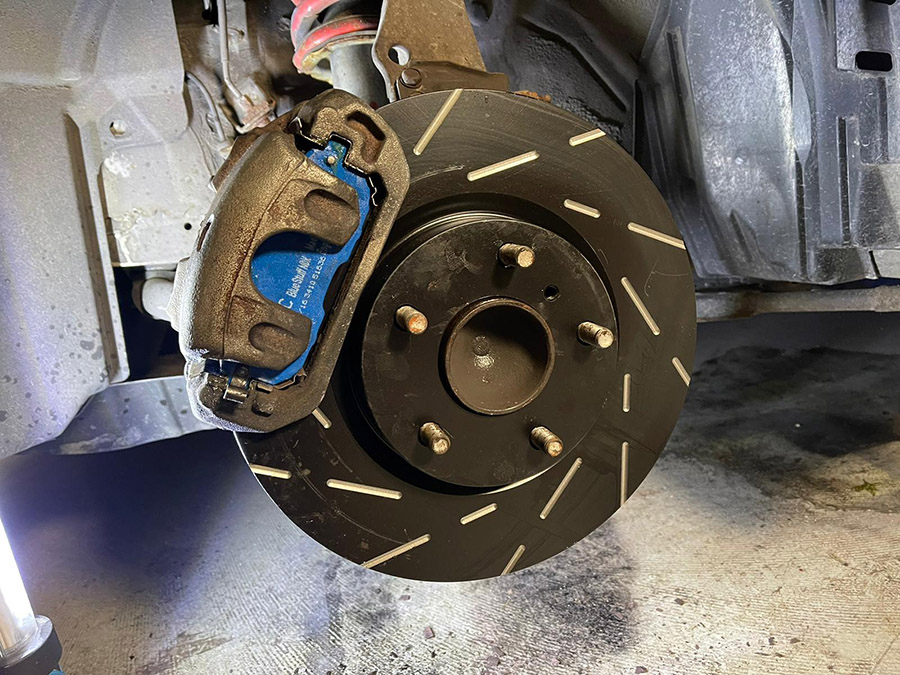
Why upgrade your brake pads and rotors?
Upgrading your rotors and pads essentially means you’ll be getting a brake system with better friction bite and/or heat tolerances.
How long do brake pads and rotors last?
Of course, the exact answer to the question will differ between cars, and frankly, between driving styles too. That being said, most brake rotors are due a replacement roughly every 50,000 to 75,000 miles. In the USA, the average driver travels just shy of 14,000 miles per year, while in the UK, that figure stands at around 7500 miles. In practice, that means that in America, cars will get through a set of rotors every 3-5 years, whereas British drivers will need to change them approximately every 6-10 years (though the upper estimate seems a bit optimistic to us).
As for brake pads, this depends on a number of factors but the most important one is how the car is driven. Typically, on road driving can get anywhere between 30,000 miles and 70,000 miles out of a set of brake pads. But this can vary massively, especially if you’ve bought a used car, you can’t always guarantee the previous owner was a careful driver.
Cars with more engine power need upgraded braking power to cope with this. Running a high performance car on insufficient brake pads will result in fast wear and reduced braking efficiency. To make brake pads last longer, avoid harsh braking and make sure the car is equipped with the right brake pads for that vehicle. Heavier vehicles require more energy to slow them down so drivers who regularly tow trailers, caravans or other vehicles might find they need to replace brake pads more frequently.
How to buy the best brake pads
Again, it comes down to what your intentions are. If you want to get new pads for your daily driver, then you’ll want to opt for a pad compound which doesn’t totally forego comfort. In that scenario, you should aim for a pad which gives you a nice balance; improved friction, but without causing too much noise or brake dust.
On the other hand, if you’re buying pads for a car which you’re only going to use on track, then who cares about noise and brake dust? In that case, all that matters is the level of friction that the pads provide. On top of that, brake fade can be a killer of track day adventures, so look out for pads (and rotors for that matter) which can endure extended use at high strain.
It’s also important to give your pads a worthy grade of caliper to sit in. Larger calipers with a greater number of pistons are able to deploy a greater amount of force onto the pad, which in turn aids pad performance against the rotor.
How to buy the best rotors
When it comes to choosing the best brake rotors for your car, there are two main factors to look out for; maximum stopping force, and ability to dissipate heat.
A larger rotor diameter means two things – more surface area for the pad compound to bite (thus causing more stopping friction), and more surface area for heat to dissipate. So, put simply, bigger rotors perform better than smaller ones. As for whether to go for a basic rotor, drilled rotor, or slotted rotor, well that depends on your intentions.
We’d only ever recommend basic rotors if you don’t intend on driving fast. So, if you’ve got a show car or a stance car, regular rotors would suffice. Holes and slots are a valuable upgrade if you’re keen on spirited driving though as they allow room for gas and dust to pass along. As such, it keeps your brakes cool, and tidies up the rotor surface of debris to ensure that the pads always have the desired level of bite. We’d suggest learning more about the nuances of slotted rotors vs. drilled rotors before deciding on a set for your car.
Oh, and if you’ve got money burning a hole in your pocket, ceramic brake rotors are well worth the investment. This high-end compound is significantly lighter than the regular iron designs that many brands use, and they tend to last longer too.
How we picked the brands
While we haven’t been able to test each and every one of the brands mentioned here directly, these recommendations are based on Fast Car’s experience and expertise when it comes to modifying cars. I, for example, have driven a number of modified cars as well as owned cars that have made use of each of the brands recommended here.
Brake Pads and Discs FAQs
How do you know when brake pads need replacing?
There’s several ways to tell when it’s time for new pads. In modern cars there’s sometimes a brake pad sensor that indicates when it’s time to get them replaced. However, this isn’t always 100 percent accurate as it relies on the pads being worn enough for two contact points to touch and complete a circuit. If the pads wear evenly this should work but that’s not always the case.
Obvious signs of significant wear are screeching, grinding, vibrating and the car pulling to one side when you brake. Decreased braking efficiency is also a good indicator that it’s time for new pads. If at any time you think there’s a problem with your brakes, always get them looked at as soon as possible.
You can check the condition of your brake pad at home by measuring pad thickness with the right tools. With the wheel on, you might be able to see the pad underneath the caliper but for a more accurate assessment, the wheel needs to come off. Pad thickness can then be measured on both sides of the disc.
It’s important to take the wheel off so you can see the pads on the inside of the brake disc as these might wear at a different rate to the outer pads. Anything less than 3mm should be replaced sooner rather than later. Make sure to take measurements along the length of the pad to see if it’s wearing unevenly.
How much does it cost to replace brake pads?
When it comes to replacement pads, your bill could look very different to someone else’s depending on whether you want a full set or just one axle’s worth, or depending on how big/powerful your car is. As a rough idea, in the US, you’re probably looking at somewhere in the region of $35-$150 for a pair (if you’re replacing just one axle), whereas in the UK it’s pretty much the same, around £35-£135. For a full set, it’ll usually be between $60-$300 / £70-£280. However, that’s just for the parts alone. If you want to have a professional fit them for you, the labor can cost anything from $80-$150 for each axle.
That’s OEM parts sorted, now what if you’re looking for a higher-performance alternative? Well, as you may expect, these upper tier parts cost a little more because of the better grade materials used. Each brand will charge you differently, but given EBC Brakes’ renowned stature in the brake pad business, we decided to use their range as a barometer. Their most popular pads are the ‘YellowStuff’ variant, and depending on your car these can cost anywhere between $100-$300 / £80-£200 per axle. Though, if you opt for slightly lesser – or better – products, expect the price to adjust accordingly below or beyond that ballpark figure.

How much does it cost to replace brake rotors?
You might think that because rotors are physically larger than pads that they probably cost a fair chunk more. However, that’s not always the case. You can buy replacement OEM rotors for anywhere between around $40 / £35 for a set of two, up to around $250 /£200, with all the same caveats as pads applied. Roughly double that budget for a full front and rear kit (though one axle may be slightly cheaper than the other), and add a bit more on top if you want to factor in the cost of labor to do the job at a garage.
As for the performance aftermarket, this is where prices can really begin to climb. Uprated brake rotors can cost anywhere from around $100 / £80 for a pair, up into four-figure territory. That will of course depend on the size, manufacturer quality, and how specialized/hardcore they are.
Should you replace all brake pads at the same time?
It’s not necessary to replace all the pads at the same time but it is advisable to replace both sets of pads on the same axle. The front pads are the ones that tend to need replacing first as these take more of the braking load. Replacing just one pad at a time can lead to uneven braking pressure which can make the car pull to one side. Fitting new brake pads to both wheels on the same axle ensures they will wear evenly over time.
Always make sure that the replacement pads match the material suggested by the manufacturer. If the front and rear brake pads don’t get replaced at the same time, make a note of how long each set lasted so you can anticipate when they might need looking at again. At every service (either annually or more frequently) ask your mechanic to take a thorough look at the brake pads and advise whether they are likely to need replacing before your next service. It’s better to use preventative maintenance when it comes to your brakes and fit a new set before they become a problem.
Can you drive with damaged brake pads?
Whilst it’s still possible to drive with damaged brake pads, we’d strongly advise not going anywhere until they are fixed. When the pads are worn down they will grind or screech and cause the car to judder or vibrate under braking pressure. It’s an awful feeling that can mean the brakes won’t work as well as they normally do. Damaged pads might make handling unpredictable and cause the car to veer off to one side.
Driving with worn brake pads can damage the discs when exposed metal rubs against them. This creates an immense amount of heat which can warp the discs and reduce what’s left of any braking power. What starts out as a simple brake pad fix can result in needing replacement discs too. Worn pads may also cause uneven wear on tires thanks to repeated hard braking or uneven pressure.
Relevant content:

